Frozen shoulder
Patients who have frozen shoulder should be done some shoulder exercises for frozen shoulder to get relief from pain which is typically advised by a physiotherapist.
Frozen shoulder is a condition where the shoulder becomes painful and stiff for no particular reason. Shoulder movements become reduced, sometimes completely ‘frozen. Typically it affects one side of the shoulder. It is also known as adhesive capsulitis.
The symptoms tend to gradually worsen over a variety of months or years. Patients typically experience shoulder pain for the primary two to nine months, which may be severe, followed by increasing stiffness.
Frozen shoulder often happens as a result of a shoulder injury, a bone fracture affecting the shoulder, or shoulder surgery. It also can happen after people produce other sorts of surgery, like a heart or operation.
Frozen shoulder also can happen without a preceding injury and tends to preferentially affect people with certain diseases and conditions. People with diabetes, for instance, have an increased risk of developing frozen shoulders. In fact, 10-20 percent of individuals with diabetes develop the condition.
It is estimated that frozen shoulder can affect 2% to 5% of the total population. It most often affects people between the ages of 40 and 60, with more women than men.
| Related Articles What is the main cause of Frozen shoulder? |
Shoulder exercises for frozen shoulder
Due to frozen shoulder mobility become reduced. For that, to regain mobility, the patient should have to create an efficient treatment plan involving stretching and some shoulder exercises for frozen shoulder. Patients should get treatment under the guidance of a doctor or physiotherapist.
The treatment for a frozen shoulder is concentrated on relieving pain and restoring the shoulder’s normal range of motion. The doctor may recommend an anti-inflammatory medication like aspirin, naproxen, or ibuprofen (Get from here). An ice pack (Get from here) or bag of frozen vegetables applied to the shoulder for 10 to fifteen minutes several times each day also can help with the pain.
Corticosteroid injection may apply to the shoulder or soft tissues. But the cornerstone of treatment is physiotherapy, concentrating first on exercises that stretch the joint capsule, and later, on strengthening exercises. A physiotherapist can show the ways far to push himself/herself and may teach him/her the acceptable exercises. Once a patient learned his/her limitations, he/she will practice most of your exercises on your own reception.
1. Pendulum exercise: Pendulum exercise is a common exercise for a frozen shoulder patient.
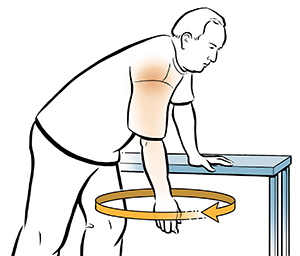
- 1st– Relax the shoulder
- 2nd– Stand beside a table about a waist height.
- 3rd– To get support place the healthy arm on the stationary object.
- 4th– Lean over slightly.
- 5th– Swing the affected arm in a small circle, about one foot in breadth, in one direction for about 10 revolutions.
- 6th– Then, reverse and swing the arm in a small circular movement within the other way for 10 revolutions like previous.
As the patient’s symptoms improve, increase the diameter of the swing, but never do it forcefully. When the patient is prepared for more, increase the stretch by holding a light-weight weight (3-5 pounds) within the swinging arm.
2. Finger Walk:
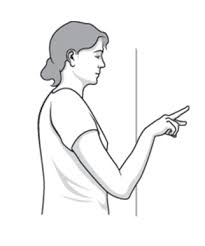
- 1st– Stand in front of a wall, about 6 to 8 inches away.
- 2nd– Touch the wall just above waist level using the hand of the affected arm with the index and middle fingers. The elbow should be bent and making a “v” with the arm.
- 3rd– “Walk” the fingers up the wall, until the arm is raised as far as the patient comfortably can.
Patient fingers should be doing the work, not the patient’s shoulder muscles. Slowly lower the arm and repeat. You may need the assistance of the good arm to lower the affected arm. Perform this exercise 10 to 20 times each day.
3. Inward rotation:
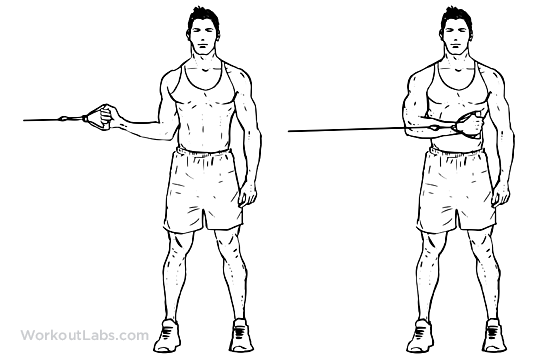
- 1st– Stand next to a closed-door
- 2nd– Hook one end of a rubber exercise band around the door handle.
- 3rd– Hold the opposite end with the hand of the affected arm, holding the elbow at a 90-degree angle.
- 4th– Pull the band inward to the body two or three inches and hold for five seconds.
- 5th– Repeat 10-15 times, once each day.
4. Outward rotation/Doorway external rotation: The patient can perform this exercise by a rubber band or by grabbing a door edge.

Using a rubber band-
- 1st– Hold a rubber exercise band between the hands with the elbows at a 90-degree angle on the brink of the patient’s sides.
- 2nd– Rotate the lower part of the affected arm outward two or three inches and hold for five seconds.
- 3rd– Repeat 10-15 times, once each day.
Article: Shoulder exercises for frozen shoulder to get relief from pain
Using a door edge-
- 1st– Stand near the center of a doorway.
- 2nd– Facing one side of the doorframe.
- 3rd– Bend the affected arm to a 90-degree angle and grab the sting of the doorframe furthest from the body with the hand of the affected arm.
- 4th– Rotate the body frontwards, therefore the backside is now within the doorway.
- 5th– Hold for 30 seconds; relax, and repeat.
5. Cross body reach: People who have severe cases of frozen shoulder might not be ready to do the cross-body stretch.

- 1st– The patient can perform this exercise by sitting or standing.
- 2nd– Use the patient’s good arm to lift his/her affected arm at the elbow, and convey it up and across the chest.
- 3rd– Exerting gentle pressure to stretch the shoulder.
- 4th– Hold the stretch for 15 -20 seconds.
- 5th– Perform this 10-20 times per day.
6. Sleeper stretch: Who has relatively mild cases of frozen shoulder this exercise could also be suited to them.
- 1st– The patient will have to lie down on the side of the affected arm, with the arm extended straight out.
- 2nd– Bend the knees at an angle.
- 3rd– Bend the affected arm, in order that the elbow forms a 90-degree angle. The forearm should be raised off the bottom and therefore the fingers pointed toward the ceiling.
- 4th– Use the hand of the healthy arm to push the affected arm toward the bottom (palm facing the ground).
- 5th– Hold each stretch for 30 to 60 seconds.
- 6th– Perform the stretch 2 to three times every day.
7. Standing extension: A light bar or cane is used in this exercise.
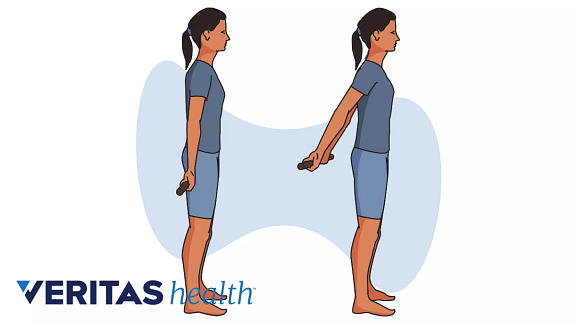
- Stand straight.
- Hold the bar horizontally behind the body. The arms are about shoulder-width apart. Position the hands therefore the knuckles face toward the bottom.
- Raise the arms until a stretch feeling.
- Repeat about 10 times.
- Hold each repetition for about 1-5 seconds.
8. Supine (Lying down) flexion: This exercise uses the patient’s good arm to assist.
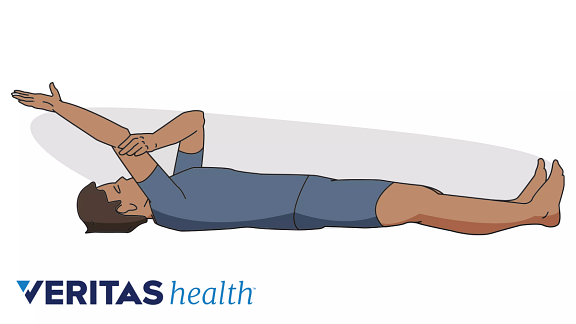
- Place it on a flat surface, such as a physical therapy table. The legs are straight, so the body is inline.
- Relax the arms on both sides of the body.
- With the help of healthy arms hang the injured arm vertically and lift it back to the floor. The good arm supports the elbow of the injured arm to help guide movement overhead.
9. Towel stretch:
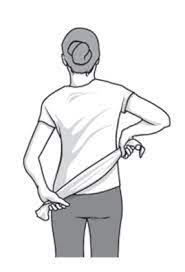
- Hold a three-foot-long towel behind the hands and place it horizontally.
- Use the good arm to lift the affected arm and stretch it out. The patient can also wrap a towel over his/her shoulders for an advanced version of this exercise.
- Grasp the bottom of the towel together with the affected arm and pull it down with the healthy arm.
- Do it 10-20 times a day.
Physiotherapists typically recommend completing physiotherapy exercises a few times every day. People with more severe cases of frozen shoulder can also enjoy other treatments, like electrical stimulation or application of warmth to the affected area. A physician or physiotherapist can also suggest alternatives to daily activities which will provide comfort and reduce tissue irritation.
Reference:

